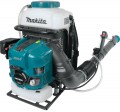Power
Engine power of the gasoline sprayer (see "Type") in horsepower.
Power directly affects the spraying range and the performance of the unit, according to this indicator, it is quite possible to assess the overall level of the device. However note that manufacturers can indicate this characteristic in different ways: some give the rated power (when the engine is running in normal mode), others give the maximum power (at peak load). Therefore, when choosing and comparing, it is worth considering not only this indicator, but also other basic characteristics.
As for horsepower, this unit is traditionally used to assess the power of an internal combustion engine. 1 HP approximately equal to 735 watts.
Noise level
The average noise level produced by the sprayer during normal operation.
The “loudness” of operation largely depends on the type of sprayer (see above): for example, battery units are generally much quieter than gasoline ones. Anyway, the lower this indicator, the more comfortable the use of the unit, especially during long-term work. Note that the decibel is a non-linear quantity, and therefore it is best to evaluate the noise level using special comparative tables.
The most "quiet" models are manual: the noise level in them is so low that it is often not indicated at all in the characteristics. Yes, and low-power battery models can work with a volume of 30 – 35 dB, which can be compared with a muffled conversation. In more advanced versions, the noise can reach 70 dB — this is already comparable to a loud conversation. For gasoline models, the same 70 dB is, in fact, the minimum indicator, while the maximum value exceeds 100 dB (the noise of an industrial workshop or a tractor engine).
Weight
The total weight of the sprayer. Specified without taking into account the liquid or powder in the working tank; at the same time, for battery models (see “Type”), usually, the weight is given with a complete battery, and for gasoline models, on the contrary, “dry” weight, without fuel in the tank.

